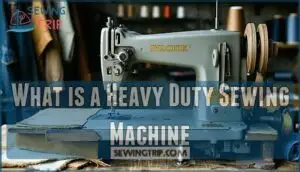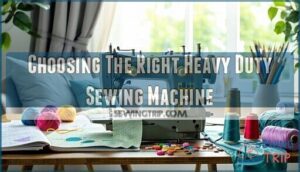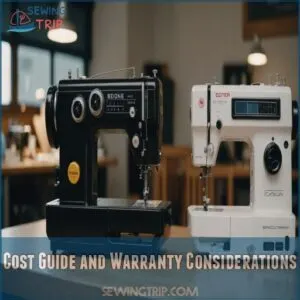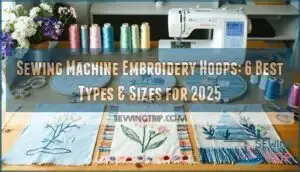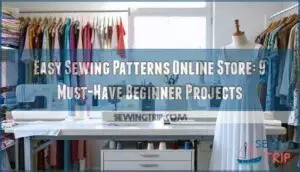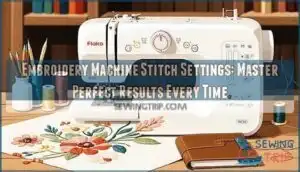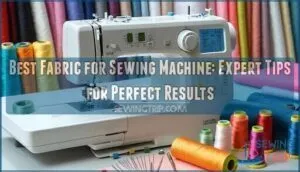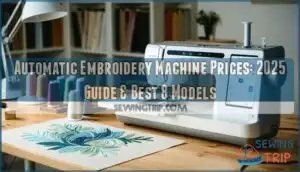This site is supported by our readers. We may earn a commission, at no cost to you, if you purchase through links.
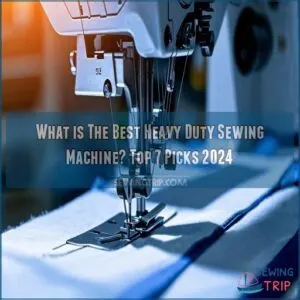 When you’re up against thick fabrics like denim or leather, you need a heavy-duty sewing machine that won’t break a sweat.
When you’re up against thick fabrics like denim or leather, you need a heavy-duty sewing machine that won’t break a sweat.
With models like the Singer CG590 and Janome HD3000, you get powerful motors and sturdy frames built to tackle those hefty tasks.
Imagine stitching away at 1,500 stitches per minute like the JUKI TL 2000Qi—now that’s sewing with flair!
These machines are durable, versatile, and perfect for both home and industrial needs.
But which one’s the best?
Find out how essentials like stitch options and accessories can make all the difference in your sewing mastery.
Table Of Contents
Key Takeaways
- Look for machines with strong motors and metal frames; they’re built to handle thick fabrics like denim and leather with ease.
- Consider the Singer CG590 or Janome HD3000 for their powerful performance, durability, and ease of use.
- Think about essential features like stitch options and accessories; these can make a big difference in your sewing projects.
- Pick a machine with a good warranty and reliable customer support to ensure long-term satisfaction and minimal hassle.
What is a Heavy Duty Sewing Machine
So, you’re wondering what makes a heavy-duty sewing machine special?
They’re built with stronger motors and sturdier parts to handle tough fabrics like denim or even leather.
Making them perfect for those ambitious sewing projects you’ve been dreaming up!
Definition and Characteristics
A heavy-duty sewing machine is your powerhouse for tackling thick fabrics like denim or leather.
Built with rugged construction, it boasts a powerful motor and speeds up to 1500 stitches per minute.
You can find a variety of industrial sewing machines for sale online, like on a website specializing in industrial sewing machines.
Whether you’re sewing for industrial needs or at home, it’s designed for longevity and multiple layers.
It’s all about handling hefty tasks with impressive ease.
Benefits of Heavy Duty Sewing Machines
Imagine tackling your toughest projects with ease. A heavy-duty sewing machine offers remarkable benefits:
- Durability: These machines are built to last, handling heavy fabrics effortlessly, including thick fabrics like denim, leather, and canvas with ease, thanks to their specialized presser feet.
- Power: Their strong motors tackle the thickest materials.
- Versatility: Perfect for all sorts of projects, from to leather.
- Performance: They keep going without overheating, ensuring your creative juices keep flowing.
Comparison With Standard Sewing Machines
Think of heavy-duty sewing machines as the workhorses compared to the ponies of standard models.
They boast durability, superior stitch quality, and impressive motor power, tackling thick fabrics like denim with ease.
Despite their higher price point, these machines deliver high performance with diverse stitch options, making them ideal for both industrial tasks and home projects.
Top 7 Heavy Duty Sewing Machines
You’re on the hunt for the best heavy-duty sewing machine, ready to tackle any fabric challenge thrown your way.
Here’s a list of the top seven contenders for 2024, blending durability and performance to help you make a confident choice.
1. Singer CG590 Commercial Sewing Machine
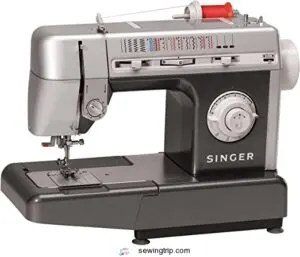
For heavy-duty sewing needs, consider features like those offered by Singer’s top models, such as the Singer Heavy Duty 4452 with automatic needle threading and high-speed performance, detailed in best Singer sewing machines reviewed. Step up your sewing game with the Singer CG590 Commercial Sewing Machine.
This powerhouse, stitching at a brisk 1,100 stitches per minute, easily handles multiple fabric layers.
Its stainless steel bed plate and mostly metal build make it durable and stable.
With features like a heavy-duty metal frame, similar to the Singer 4432’s metal components, this machine is designed for heavy use.
Plus, the intuitive settings and minimal electronics mean fewer malfunctions.
While it’s easy to use, be aware of its table-shaking motor and the need for extra lighting.
The 90-day parts warranty is a factor to think about for long-term use.
Best For: The Singer CG590 is best for experienced sewers who need a durable machine for heavy-duty projects.
- Powerful motor handling multiple fabric layers.
- Durable construction with a stainless steel bedplate.
- Easy to use with intuitive settings and minimal electronics.
- Motor can shake the table if it’s not sturdy.
- Poor lighting may require an additional light source.
- Limited 90-day warranty on parts.
2. Janome HD3000 Heavy Duty Sewing Machine
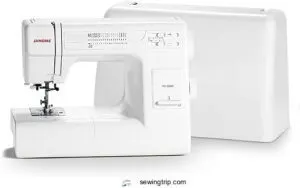
When you’re tackling tough sewing projects, Janome’s HD3000 shines.
This mechanical wonder manages thick and thin fabrics alike, making it ideal for ambitious DIYers.
With 18 stitches, a one-step buttonhole, and a built-in needle threader, it’s designed for ease.
Whether you’re crafting sails or hemming denim, its reliability stands out.
There’s an extra-high presser foot lift and convenient free arm for those tricky spots.
Despite minor quirks, like short cords, its solid performance makes it a valuable ally in your sewing arsenal.
Best For: The Janome HD3000 is best for experienced sewers tackling heavy-duty projects like denim, sails, and upholstery.
- Handles both thick and thin fabrics with ease.
- Includes helpful features like a one-step buttonhole, built-in needle threader, and extra-high presser foot lift.
- Offers good value for the price compared to similar models.
- The foot control cord is short.
- The feed dog spring-loaded lever may be out of alignment during shipping.
- Some users have reported uneven stitches and looping.
3. Singer Heavy Duty Sewing Machine
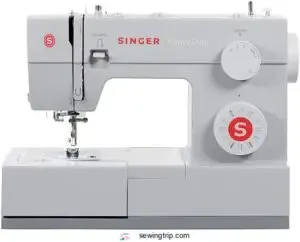
Power through tough fabrics with the Singer Heavy Duty sewing machine.
Its robust metal frame and strong motor tackle even the thickest denim.
You’ll appreciate the 97 stitch options, from basic to decorative.
The automatic needle threader saves you time, and the bright LED lighting provides clear visibility.
While some users mention occasional bobbin jams, proper maintenance is key.
Remember to use the right needles and thread for best results.
You’ll master any sewing project with this workhorse.
Best For: Investing in a heavy-duty sewing machine, such as those from top sewing machine brands for heavy fabrics, significantly enhances your ability to handle thick fabrics. This sewing machine is best for those who frequently sew thick fabrics, like denim and upholstery.
- Robust construction and powerful motor for handling heavy fabrics.
- Wide range of stitch options, including both basic and decorative stitches.
- Automatic needle threader for convenience.
- Some users have reported issues with thread tension and bobbin jams.
- The foot control can be difficult to manage for fine control.
- The manual may not be comprehensive enough for all users.
4. Brother ST371HD Sewing Machine
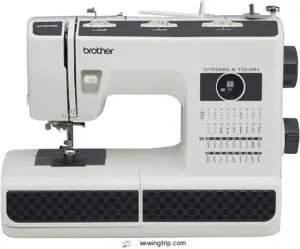
Get into the world of sewing with the Brother ST371HD, a strong contender in the heavy-duty category.
This machine, boasting 37 built-in stitches, including those tricky buttonholes, is versatile enough for most projects you’ll tackle.
With an automatic needle threader and a drop-in bobbin, it’s beginner-friendly yet powerful.
A free arm makes sure you can work on sleeves and cuffs with ease.
However, watch out for those control buttons—they can be a bit confusing at first, but practice makes perfect!
Best For: This machine is best for beginners and intermediate sewers who want a reliable and versatile machine for a variety of projects.
- Automatic needle threader and drop-in bobbin make threading a breeze
- 37 built-in stitches, including buttonholes, provide versatility
- Free arm allows for easy sewing of sleeves and cuffs
- Control buttons can be confusing for some users
- Needle threader can be difficult to use and may require practice
- No automatic thread cutter
5. JUKI TL 2000Qi Sewing Quilting Machine
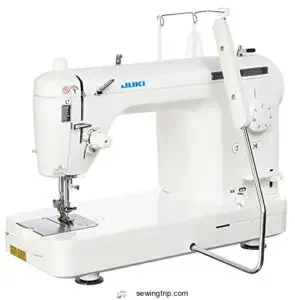
Are you looking to quilt like a pro?
The JUKI TL 2000Qi Sewing Quilting Machine might be your perfect partner.
It zooms at 1500 stitches per minute, making it both fast and efficient.
With an automatic needle threader and cutter, plus an extension table, it’s built for ease and precision.
Its aluminum die-cast body helps minimize vibration, providing a smooth sewing experience.
Just remember, it may need frequent oiling and a voltage converter for certain regions.
Ready, set, sew!
Best For: The JUKI TL 2000Qi Sewing Quilting Machine is best for quilters of all levels, from beginners to experienced sewers.
- Quiet and easy to use, even for beginners.
- Heavy-duty and reliable, built to last.
- Great for quilting with perfect stitch quality, especially for achieving a quarter-inch seam.
- Requires frequent oiling.
- May need a voltage converter for users in certain regions.
- Doesn’t offer decorative stitches.
6. Brother Computerized Sewing Quilting Machine
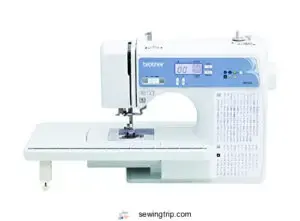
The Brother Computerized Sewing Quilting Machine is your go-to partner for sewing mastery.
Equipped with 165 built-in stitches, you can express your creativity with utility, decorative, and heirloom options.
An automatic needle threader saves you time, while the drop-in top bobbin ensures smooth operation.
Even if the pressure foot tension isn’t the easiest to adjust for thick fabrics, you’ll appreciate the machine’s lightweight design.
Perfect for various projects, this device keeps you in control, making each stitch count.
A practical choice indeed!
Best For: The Brother XR9550 is best for beginners and intermediate sewers who are looking for a versatile machine with a wide range of stitch options and user-friendly features.
- Lightweight and sturdy design
- Drop-in clear bobbin case for easy threading
- Many quick-change presser feet for various projects
- The pressure foot tension can be difficult to adjust for thicker materials
- The hard case is not a carrying case
- The horizontal thread placement can cause thread mishaps
7. Janome Blue Couture Sewing Machine
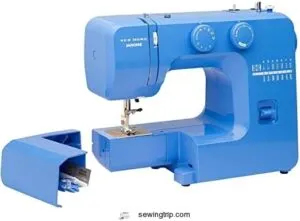
Considering a versatile machine, the Janome Blue Couture is a stellar choice for both beginners and seasoned sewists.
With its sturdy metal frame and 15 built-in stitches, it tackles various projects with ease.
The front-loading bobbin and adjustable stitch settings keep things user-friendly, while the range of included feet offers creative options.
At a lightweight 12 pounds, it’s portable yet durable.
For those seeking mastery without breaking the bank, this machine balances affordability and performance, making it a smart addition to any sewing toolkit.
Best For: The Janome Blue Couture is great for beginners and experienced sewists who want a versatile, affordable machine.
- Sturdy metal frame for durability
- User-friendly features like front-loading bobbin and adjustable stitch settings
- Comes with a variety of feet for creative options
- Doesn’t include an invisible zipper foot
- Requires a US-to-international adapter for use outside of the US
- Some users recommend purchasing an adjustable invisible zipper foot separately
Choosing The Right Heavy Duty Sewing Machine
When you’re choosing the right heavy-duty sewing machine, consider your sewing needs, budget, and key features such as stitch options and accessories.
It’s like picking the perfect pair of shoes—comfort and durability are a must, but don’t forget style and functionality!
Type of Sewing Machine
Questions linger about which machine suits your style.
Are you eyeing mechanical reliability or the sophisticated touch of computerized models?
Mechanical vs. Computerized—each has its charm.
Top sewing machine brands like Singer and Brother cater to these needs, offering powerful motors and durable frames.
So, dig deeper.
Your masterpiece awaits with the perfect heavy-duty sewing machine fit.
Stitch Options and Adjustments
So, you’ve picked your machine type.
Now, let’s talk stitch options.
A heavy-duty sewing machine designed for professional-level stitching and tougher fabrics, as seen in best industrial sewing machine, offers a higher level of durability and performance. A heavy-duty sewing machine‘s versatility hinges on its stitch selection.
For a detailed comparison of various heavy-duty sewing machines and their features, check out heavy duty sewing machine reviews.
You’ll find a basic straight stitch, a handy zigzag stitch, and maybe even more stitch types.
Adjusting stitch length and width is key; experiment to find what works best for your fabric.
Remember, the right needle selection impacts stitch quality.
Mastering these adjustments lets you fully use your machine’s capabilities.
Essential Accessories and Features
For heavy duty sewing projects, a machine like the Singer 4411 with 11 built-in stitches and a metal interior frame can be a great option. For the perfect heavy duty sewing machine, consider these must-have accessories and features.
Use a Foot Pedal for smooth control.
Explore various Needle Types for flexibility.
Check Stitch Plate Choices that suit your needs.
Enjoy the versatility of a Presser Foot Variety.
These will empower your crafting, ensuring creativity flows without interruption.
Cost Guide and Warranty Considerations
When choosing a heavy-duty sewing machine, it’s important to think about your budget and how various factors, like brand and features, influence the price.
Don’t forget to check the warranty details and customer support options—no one wants to be left in stitches without backup!
Price Range and Factors Affecting Cost
Finding the right sewing machine involves more than choosing features.
Consider your budget and the sewing machine cost.
Heavy-duty machines span a broad price range, influenced by brand, quality, and features.
Higher-priced models often mean better build and advanced options.
Balancing your needs with what fits your wallet helps make sure you get the best bang for your buck.
Importance of Warranty and Customer Support
A good warranty and stellar customer support can make all the difference when choosing a heavy-duty sewing machine.
You’re not just buying a tool, you’re investing in a safety net.
When shopping for a heavy-duty sewing machine, consider visiting websites like Heavy Duty Sewing Machines for reliable options.
Keep an eye out for:
- Warranty duration – longer is better.
- Repair costs – important for budgeting.
- Parts availability – guarantees smooth operation when needed.
Frequently Asked Questions (FAQs)
What is the best sewing machine for heavy duty sewing?
Picture a trusty workhorse in your sewing room—Janome HD1000 stands out as the best heavy-duty sewing machine.
It tackles thick fabrics effortlessly with its sturdy build, ensuring your projects are smooth and frustration-free.
Which sewing machine has the least problems?
If you want a sewing machine with minimal issues, consider the Janome HD
It’s known for its robust build, ease of use, and reliability.
Whether you’re tackling denim or quilting, this machine handles it all.
What is the most reliable brand of sewing machine for the money?
Consider Brother and Janome as top contenders for reliability and value in sewing machines.
They offer a range of models that balance performance and price, making them great picks for users seeking dependable, budget-friendly options.
What is the strongest type of sewing?
The lockstitch is the strongest type of sewing, creating a secure and durable seam.
It interlocks threads from a needle and a bobbin, making it perfect for heavy fabrics like denim or leather.
Always use it for sturdy projects!
Can heavy-duty machines sew leather?
Tackling leather with a heavy-duty sewing machine is like conquering a mountain with a trusty pair of boots.
These machines are powerhouses, designed for thicker materials, ensuring your leather projects are sewn smoothly and efficiently.
Whats the best machine for denim?
If you’re tackling denim, the Janome HD1000 is your go-to choice.
It combines solid construction with impressive power to sew thick fabrics confidently.
Durable and reliable, it’s perfect for transforming tough, rugged denim into wearable art.
How much maintenance do they need?
Did you know that regular maintenance can extend a machine’s lifespan by years?
You’ll need to clean lint, oil moving parts, and replace needles regularly.
It’s a small price to pay for years of smooth sewing!
Are heavy-duty machines noisy?
Heavy-duty sewing machines can be noisier than standard ones because they’ve more powerful motors.
Heavy-duty sewing machines, like the Janome Heavy-Duty Sewing Machine models, are built to handle thick fabrics, which might result in a higher volume.
While tackling thick fabrics, you might hear a higher volume, but it’s a trade-off for the strength and durability they offer.
Do they come with a warranty?
Imagine snagging a great deal on a heavy-duty sewing machine, only to find it broken after a week!
Many heavy-duty machines come with warranties, usually ranging from one to five years, covering parts and labor.
Conclusion
When choosing the best heavy duty sewing machine, consider the benefits of owning a machine that can handle thick fabrics and multiple layers, remember, "don’t judge a book by its cover
Each machine, from the Singer CG590 to the Janome Blue Couture, offers unique strengths suited to your needs.
Whether you’re tackling thick fabrics or need versatile stitch options, there’s a machine here ready to handle the job.
Consider your sewing style, budget, and features you can’t live without, and you’ll sew up success with flair and ease.
- https://sewinginsight.com/best/best-heavy-duty-sewing-machines/
- https://www.usnews.com/360-reviews/home-goods/best-sewing-machines
- https://sewingfromhome.com/best/heavy-duty-sewing-machine/
- https://www.nytimes.com/wirecutter/reviews/best-sewing-machine/
- https://www.forbes.com/sites/forbes-personal-shopper/article/best-sewing-machines/

